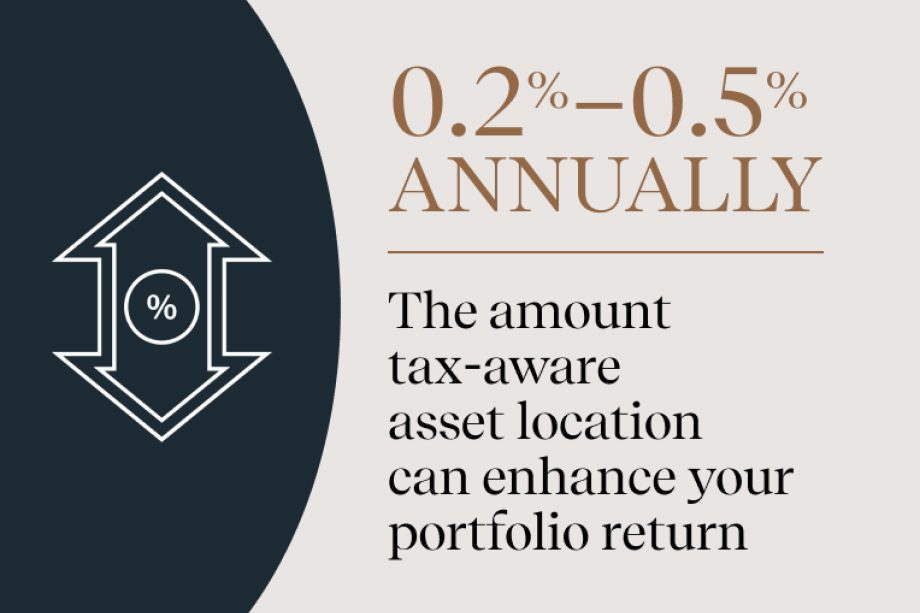Goals-based planning
1 minute read
5 year-end tax-planning actions to take before 2026


Investment portfolios have something in common with high income earners: The money may be flowing in, but the well-compensated can still struggle to build wealth if a large chunk of what they’ve earned is consumed by spending or servicing debt.
The same holds true for the investment portfolios of high- and ultra-high net worth individuals. They may be earning strong returns, yet those may not translate into more spendable wealth if high tax rates create an ongoing tax liability—often referred to as tax drag—that is systematically consuming a portion of portfolio returns.
Tax drag cannot be eliminated, but there are a number of ways to reduce it.1 Here we discuss one thoughtful approach: Intentionally choosing the right type of account in which to hold your assets—a tax planning concept called asset location. (It shouldn’t be confused with asset allocation—diversifying across asset classes, balancing risk and return, spreading and managing risk.)
Asset location is a demonstrably powerful strategy for creating more spendable wealth.
Asset location involves strategically placing investments in the optimal type of account: taxable, tax-deferred or tax-free. When properly implemented, tax-aware asset location can enhance portfolio returns by 0.2% to 0.5% annually, studies have shown.2
Of course, factors such as your tax rate, time horizon, the account types you have access to (and your particular investment instruments) will influence the strategy’s impact.
Setting aside, for our purposes, real estate and other real assets, a portion of your balance sheet is liquid: equities, fixed income, liquid alternative investments and cash. Asset location begins with recognizing that generally three types of accounts can hold those assets, each with distinct attributes:
An investment’s return potential, and its tax efficiency, determine the optimal account location, as the diagram illustrates.
Let’s unpack the diagram:
High tax efficiency, high return potential assets: Tax-efficient asset classes with higher return potential, such as private equity and stocks with a low turnover, are best suited for taxable accounts because they’re already benefiting from preferential tax rates. (They would take a long time to realize the advantages of tax deferral.) In these cases, moving into a tax deferred account would involve a tradeoff: giving up ongoing taxes at lower preferential rates in exchange for a tax liability at (likely higher) ordinary income tax rates in the future. (A theoretical scenario for a taxpayer in the highest bracket: Moving a private equity fund that mostly generates long-term capital gains into a tax-deferred account would mean trading a 23.8% tax rate today for a 37% rate in the future.)
Moderate tax efficiency, lower return potential assets: Investments such as intermediate Treasuries and global infrastructure, which have lower return potential and/or moderate tax efficiency, may be appropriately located in taxable or tax-deferred accounts. The impact of their location is small.
Tax-inefficient assets with higher return potential: Private credit and high yield bonds, for example, would receive an immediate benefit from being located in a tax-deferred account. The income these asset classes generate is taxed at higher ordinary income rates than other types of income, such as long-term capital gains or qualified dividends, so deferring payment makes sense.
If you have access to tax-free account types, they are excellent locations for assets with the highest returns and least tax-efficiency. When placing investments in tax-free accounts it is reasonable to prioritize their growth over tax efficiency.
The cost of getting account location wrong is forfeiting what we call asset location alpha. An example of that might be when an investor owns a tax inefficient investment instrument in a taxable account that could have been owned in a tax-advantaged account type. Such location errors become especially pronounced when you’re subject to top tax rates. The disadvantage becomes ever more costly if tax rates rise over time, and as the years pass, as the table illustrates.
The Internal Revenue Code, the U.S. law governing taxation, recognizes the benefits of tax deferral and as a result, imposes contribution limits and phaseouts on certain account types. Consequently, high-income earners often face restrictions on how much they can contribute to more traditional tax-advantaged accounts such as IRAs and 401(k)s.
A private placement variable annuity (PPVA) can be an effective solution if you:
In those cases, it may make sense to purchase additional tax deferral through a PPVA.
A PPVA would enable you to access tax deferral on a selection of investments, including alternative assets that are not typically available in standard annuities. However, the IRS taxes withdrawals from a PPVA as ordinary income, and withdrawals prior to age 59½ may be subject to penalties. Despite these important considerations, for high-income earners seeking additional tax-deferral, a PPVA can be valuable.
Where to put which investments is obviously a complex question—but one well worth considering carefully. Your J.P. Morgan team is available to work with you and your tax advisors to help you make sure your decisions truly support your long-term goals.



We can help you navigate a complex financial landscape. Reach out today to learn how.
Contact usLEARN MORE About Our Firm and Investment Professionals Through FINRA BrokerCheck
To learn more about J.P. Morgan’s investment business, including our accounts, products and services, as well as our relationship with you, please review our J.P. Morgan Securities LLC Form CRS and Guide to Investment Services and Brokerage Products.
JPMorgan Chase Bank, N.A. and its affiliates (collectively "JPMCB") offer investment products, which may include bank-managed accounts and custody, as part of its trust and fiduciary services. Other investment products and services, such as brokerage and advisory accounts, are offered through J.P. Morgan Securities LLC ("JPMS"), a member of FINRA and SIPC. Insurance products are made available through Chase Insurance Agency, Inc. (CIA), a licensed insurance agency, doing business as Chase Insurance Agency Services, Inc. in Florida. JPMCB, JPMS and CIA are affiliated companies under the common control of JPMorgan Chase & Co. Products not available in all states.
Please read the Legal Disclaimer for J.P. Morgan Private Bank regional affiliates and other important information in conjunction with these pages.
Bank deposit products, such as checking, savings and bank lending and related services are offered by JPMorgan Chase Bank, N.A. Member FDIC.
Not a commitment to lend. All extensions of credit are subject to credit approval.
